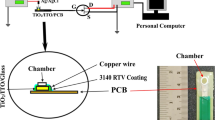Abstract
A miniaturepH glass electrode for possible clinical and biomedical applications was constructed and evaluated in referencepH buffer solutions at 36°C. A field-effect-transistor (f.e.t.) amplifier was integrated into the system, and its effectiveness was investigated. The average e.m.f. efficiency of the developed electrode was 0·87±0·11V, and a minimum length of 7 mm was required for a goodpH response. Temperature dependence of the electrode was −1·51 mV/oK at apH of 7. Evaluation of the stability of the electrode showed a 1% drift over a 7 h operational time. ThepH and temperature hysteresis effects showed 0·5% and 1·0% deviations, respectively. The response time was within 4 s for 99% response. These electrode characteristics were also investigated in blood plasma and discussed.
Sommaire
Une électrode miniature depH en verre destinée à des applications cliniques et biomédicales éventuelles a été construite puis évaluée dans des solutions tamponspH de référence, à la température de 36°C. Un amplificateur à transistor à effet de champ (f.e.t.) a été intégré au système et son efficacité a été étudiée. La f.é.m. moyenne du système de l'électrode mise au point était de 0·87±0·11, et une longueur minimum de 7·0 mm était nécessaire pour une réponsepH satisfaisante. La dépendance de température de l'électrode était de −1·51 mV/oK à unpH de 7. L'évaluation de la stabilité de l'électrode présentait un glissement de 1% pendant une durée de fonctionnement de 7 h. Les effets d'hystérésis température etpH présentaient des écarts de 0·5% et de 1·0%, respectivement. Le temps de réponse se situait dans les limites de 4 s pour une réponse de 99%. Ces caractéristiques d'électrode que nous débattons ont également été examinées dans le plasma sanguin.
Zusammenfassung
Es wurde eine Miniatur-pH-Glaselektrode für eine eventuelle klinische und biologischmedizinische Anwendung gebaut und in bezung aufpH-Pufferlösungen bei 36°C beurteilt. Ein Feldeffekttransistor-Verstärker (f.e.t.) wurde in das System eingebaut, dessen Wirksamkeit untersucht wurde. Die effektive durchschnittliche Leistungsfähigkeit der entwickelten Elektrode betrug 0·87±0·11. Für gutepH-Reaktionen war eine Mindestlänge von y mm erforderlich. Die Temperaturabhängigkeit der Elektrode betrug—1·51 mV/oK bei einempH-Wert von 7. Bei der Bewertung der Elektrodenstabilität zeigte sich eine Abweichung von 1% bei einer Einsatzdauer von 7 Stunden.pH- und Temperatur-Hystereseeffekte zeigten Abweichungen von 0·5 bzw 1·0%. Bei 99% der Reaktionen lag die Reaktionszeit innerhalb von 4 Sekunden. Diese Elektrodeneigenschaften wurden ferner im Blutplasma untersucht und besprochen.
Similar content being viewed by others
References
Hughes, W. S. (1922) The potential difference between glass and electrolytes in contact with the glass.J. Am. Chem. Soc. 44, 2860–2867.
Hughes, W. S. (1928) On Haber's glass cell.J. Chem. Soc., Pt. 1, 491–506.
MacInnes, D. A. andDole, M. (1929) Tests of a new type of glass electrode.Ind. Engng., Chem. Anal. Ed. 1, 57–59.
MacInnes, D. A. andDole, M. (1930) The behaviour of glass electrodes of different compositions.J. Am. Chem. Soc. 52, 29–36.
MacInnes, D. A. andBelcher, D. (1931) Further studies on the glass electrode.J. Am. Chem. Soc. 53, 3315–3331.
Dole, M. (1941a)The glass electrode. Wiley.
Bates, R. G. (1964a) In:Determination of pH, theory and practice, Wiley, 289–338.
Eisenman, G. (1967) In:Glass electrodes for hydrogen and other cations. Ed.G. Eisenman. Marcel Dekker, 133–173.
Bates, R. G. (1964b) In:Determination of pH, theory and practice. Wiley, 315–319.
Diamond, J. J. andHubbard, D. (1951) Thickness of glass electrodes.J. Res. Nat. Bur. Std. 47, 443–448.
Siggard-Andersen, O. (1961) Factors affecting the liquid junction potential in electrometric bloodpH measurement.Scand. J. Clin. Lab. Inv. 13, 205–211.
Fricke, H. K. (1959) In:Beiträge zur angewandten Glasforschung. Ed.E. Scott. Wissenschaftliche Verlagsges, 175.
Dole, M. (1941b) In:The glass electrode. Wiley, 154.
Author information
Authors and Affiliations
Rights and permissions
About this article
Cite this article
Ahn, B.K., Liu, C.C., Wist, A.O. et al. Development of a miniaturepH glass electrode with field-effect-transistor amplifier for biomedical applications. Med. & biol. Engng. 13, 450–456 (1975). https://doi.org/10.1007/BF02477118
Received:
Accepted:
Issue Date:
DOI: https://doi.org/10.1007/BF02477118




